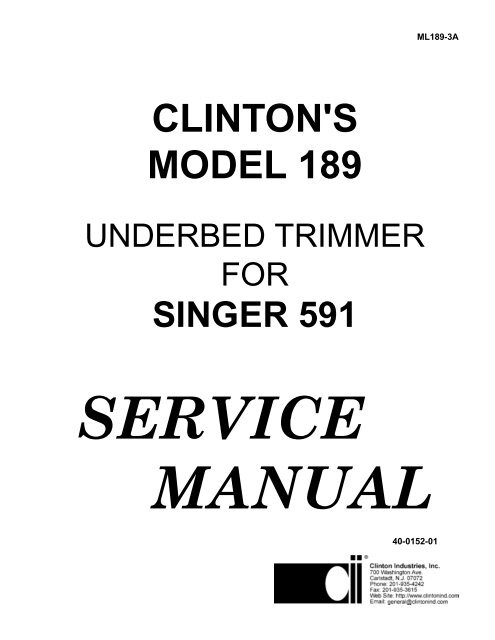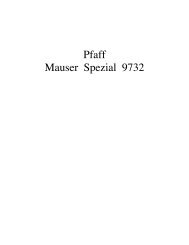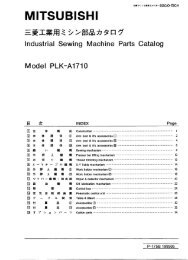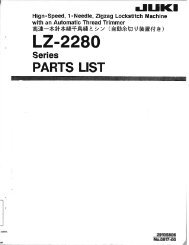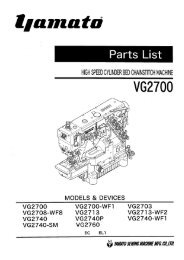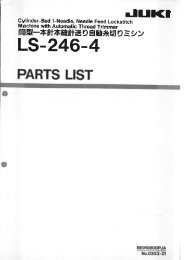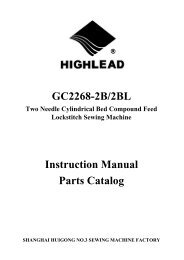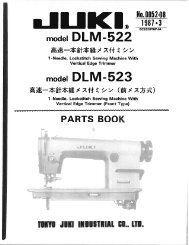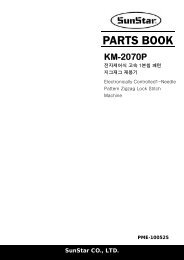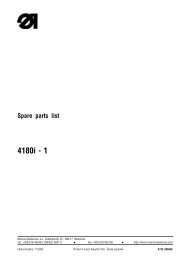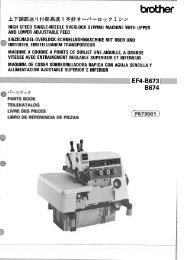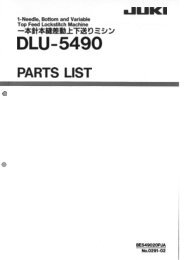clinton's model 189 - Superior Sewing Machine and Supply Corp.
clinton's model 189 - Superior Sewing Machine and Supply Corp.
clinton's model 189 - Superior Sewing Machine and Supply Corp.
You also want an ePaper? Increase the reach of your titles
YUMPU automatically turns print PDFs into web optimized ePapers that Google loves.
ML1889-26I. GENERAL INFORMATIONA. INTRODUCTIONThe air Operated Underbed Trimmer contains a trimming system that cuts both theneedle <strong>and</strong> bobbin threads simultaneously. A movable <strong>and</strong> a stationary blade, mountedon the throat plate are used in combination to pick up <strong>and</strong> cut the threads.Solid state electronics are used to sense the position of the needle <strong>and</strong> to trigger thetrimming mechanism at the proper time as well as to control footlifting <strong>and</strong> backtackingoperations.B. APPLICATIONThe underbed Trimmer/Positioner enables the operator to automatically control theposition of the needle in or out of the work, thereby eliminating the need for h<strong>and</strong> positioning.In addition, the top <strong>and</strong> bottom threads are automatically cut beneath the throatplate after positioning. This eliminates the need for h<strong>and</strong> trimming.C. TRIMMER COMPONENTSThe trimmer components, which can be either pre-installed on the sewing machine head<strong>and</strong> factory tested, or field installed, include:1. St<strong>and</strong>ard Componentsa. Thread Cutter Assemblyb. Tension Release Assemblyc. Needle Thread Pulloff Assemblyd. Needle Thread Blower <strong>and</strong> Needle Cooler Assemblye. Foot Lifterf. Folder Openerg. Solenoid Air Valve Control Unit- 1 -
vendors are getting more bang for their buck by allowing their affiliates to leverage the work that hasalready been done creating product videos. Since it's such a win-win, it's EASY to get permission to use avendor's video, which means you'll have a huge pool of products <strong>and</strong> videos to choose from. Want Proof?Case Study #1 Eric discovered this strategy back in March of 2006, when he become an affiliate of aprogram called Secret Article Converter. He found that the demonstration video on the sales page was apowerful piece of evidence, <strong>and</strong> he knew that if people watched it they'd be sold on it. The problem wasthat the video was just one little link on the sales page, <strong>and</strong> visitors had to go through a squeeze pagejust to get to the sales page. So Eric set up his own page simply with the video <strong>and</strong> his affiliate link.Instead of sending referrals directly to his affiliate link (in which case they might not even see the salespage, let alone the video), he sent them to his video page to make it 100 certain that they would see thevideo (<strong>and</strong> keep in mind that Eric did NOT make the video himself... it was already made by the vendor).He became one of their top affiliates, <strong>and</strong> has received a commission check from Secret Article Converterevery month since then. Commissions: $7,429.75 <strong>and</strong> counting Case Study #2 When Eric promoted aprogram called CB Niche Builder, he once again found that the demonstration video was an excellentsales tool. Eric made a page containing the product vendor's video (no work for Eric!), <strong>and</strong> sent viewers ofthe video to his affiliate link. This strategy helped propel him to a nice commission of over $2000.00.Commissions: $2,347.00 Case Study #3 Michael has a lot of good case studies; here is a cool study inwhich Michael used a vendor's video to promote Competition Dominator... It all started with a short emailhe received from one of his list members who wrote: " Help Michael! The Link for the CompetitionDominator video does not play." What was happening is something common that happens whenvendors show a video on their webpage; the video gets over-loaded when too many site visitors are tryingto play it. Come to think of it, if more affiliates would show videos on their own sites it would probablyeliminate most of the "launch day server crashes" we've seen in the past year. Michael knew peoplereally wanted to see this video but they couldn't <strong>and</strong> he was losing commissions fast unless he didsomething for them. So, as an affiliate for the product he contacted the vendor, <strong>and</strong> got permission to usethe video. In fact, he used the first version of Affiliate Video Br<strong>and</strong>er (the test <strong>model</strong>) to see if it wouldsave the day <strong>and</strong> he was able to download the video <strong>and</strong> br<strong>and</strong> it with his own affiliate link, <strong>and</strong> that wasthe big test to see if the link would work <strong>and</strong> sales would convert by showing a video at his site. It paid off,<strong>and</strong> it continues to be a killer strategy every time he uses use it. Commissions: $4,890.87 We have many
ML1889-28The needle is raised to the up position <strong>and</strong> the trim valve is deenergized.(See INS-1933-4). The flow control in the pilot valve actuator circuit leaks the air slowlyfrom the actuator keeping the valve shifted. Air is applied to the IN port through the NCport, now open, to the thread pulloff cylinder, tension release cylinder <strong>and</strong> throat plateblower tube.The pilot valve returns (INS-1939-5). Air is applied to the trim cylinder to return theblade. The rate or speed of return is controlled by the flow control which controls the airexhausting from the trim cylinder. This control is used to minimize bobbin spin.C. FOOTLIFT, FOLDER OPENER <strong>and</strong> THREAD BLOWERWhile the treadle brake is still applied the foot lift solenoid valve will energize(see INS-1939-5). Air is applied to the foot lift cylinder <strong>and</strong> the folder opener. The foldercan be operated independent of the footlifter at any time in the cycle with a knee operated air valve.At the same time air is applied to the double pilot valve actuators. One actuator has alarger piston than the other. The larger piston will have more force than the smaller oneat the same pressure. The air flow to the larger piston is restricted by the flow to thelarger piston is restricted by the flow control When air is first applied the smaller pistonwill shift the valve <strong>and</strong> open the port to the shuttle valve. Air will flow to the needlethread blower. Pressure is slowly increasing in the larger piston until it overcomes theother <strong>and</strong> shuts off the air supply to the blower.IV. ADJUSTMENTSA. TRIMMER1. Cutter AssemblyIn the cut position the cutting edge of the movable blade should pass the cuttingedge of the stationary blade about 1/16". If adjustment is required loosen the locknuts on the cylinder shaft <strong>and</strong> adjust as required.The pickup position on the movable blade is controlled by the stroke length of thecylinder <strong>and</strong> proper positioning of the cutting edge as above.2. Thread Pulloff <strong>and</strong> Tension ReleaseNo adjustment is required for the Thread Pulloff <strong>and</strong> Tension Release assemblies fortrimmer operations. If check spring adjustment is required for stitch formation,remove the assembly from the machine, loosen the stud lockscrew, adjust springtension, tighten lockscrew <strong>and</strong> replace assembly.- 3 -
ML1889-29B. THREAD PULLOFF CYCLE TIMEThe flow control in this circuit determines the time these cylinders have to completetheir stroke. Too much time will show a noticeable hesitation before return of the pulloffcylinder. If the time is short the cylinder will not complete its stroke. Turning is (cw) willincrease time, turning out (ccw) will decrease time.C. TRIM CYLINDER SPEEDTurning the flow control needle in (cw) will slow down the cylinder <strong>and</strong> reduce spin.Turning out (ccw) will increase cylinder speed. If cylinder speed is too slow the presserfoot will rise before the thread is cut <strong>and</strong> the operator could start removing the garmenttoo soon. If this happens the cylinder speed should be increased <strong>and</strong> some mechanicaldevice such as star springs used in conjunction with the flow control to reduce spin.D. NEEDLE THREAD BLOWER BLAST TIMEThe duration of this blast is controlled by the flow control mounted to the larger actuator.Turning in (cw) increases time turning out (ccw) decreases time. About one second isenough to give the operator time to remove the garment <strong>and</strong> blow the thread above thefoot. Should the operator be delayed in removing the garment the thread will remainunder the foot. If the foot is lowered <strong>and</strong> again raised the above sequence will repeat.- 4 -
V. TROUBLE SHOOTINGML1889-30APROBLEM CAUSES CORRECTIVE ACTIONNeedle thread not cut.Bobbin thread is cutBoth threads not cut notpicked upBoth threads picked up, notcutNeedle thread cut shortLong tail left on top side atstart of sewingBobbin thread is cut shortDefective PC BoardMovable blade missedneedle loopBinds in trimmer linkageDefective movable bladeWater in air linesDefective solenoid air valveor air cylinderDefective PC boardBinds in trimmer linkageDefective movable orstationary bladeStroke misadjusted failingto reach cutting positionPulloff cylinder improperlyadjustedBlower not operatingcausing thread to betrapped under presser foot.Operator not removinggarment fast enoughBobbin tension too tightBobbin thread slipped out ofhook on caseBobbin case without hookbeing usedReplace boardCheck synchronizer timingto see that trimmer is firedat correct timeLocate <strong>and</strong> remove bind. Alight bind would slow itenough to miss needle loopReplaceCheck filter. Remove waterfrom air linesRepair or replaceReplace boardLocate <strong>and</strong> remove bindReplaceReadjustReadjustCheck blower circuit q<strong>and</strong>flow control adjustment. Ifblower time is shortreadjust flow control toincreaseLoosen bobbin tension asmuch as possibleRun Bobbin thread throughhookReplace with correct bobbincase- 5 -
INS-1940EML1889-31CFOLDER ASSEMBLYMODEL <strong>189</strong>SINGER 59180-0384-0133-1710-01FLAT WASHERFOLDER ASS'YSEE NOTE30-1936-01AIR CYLINDER33-1508-01HEX NUT01-3066-01SCREW01-3286-01BUSHING33-0706-24SCREW-FIL.H.M.S.33-1806-01INTERNAL TOOTH WASHER33-1506-01HEX NUTNOTE: ALL PARTS NOT IDENTIFIED ARE SUPPLIED BY SINGER. SEE SINGER PARTS MANUAL.30-1783-01ELBOW01-6940-01BLOCK33-3105-05SCREW S.H.C.S.33-1805-01LOCK WASHER30-0463-01RETAININGRING01-3800-01PIN01-6941-01ROD30-1164-01NUT01-6942-01BLOCK01-6944-01NUT30-0813-01O-RING01-6945-01ESNA NUT30-0920-01AIR CYLINDER30-1729-01AIR FITTING01-6943-01RODTHREAD PULLOFF AND CUTTER DRIVE ASSEMBLYMODEL <strong>189</strong>SINGER 59180-0382 -0180-0383-0101-6939-01FACE PLATE10-0991-01THREAD NIPPERASSEMBLY30-1729-01AIR FITTING80-0338-01AIR CYLINDER01-3061-11SCREW F.H.M.S.01-6947-01BRACKETINS-1944F30-0618-01NUT01-4907-01LINK33-1628-02HEX NUT
ML1889-32D33-0105-04SCREW-P.H.M.S.EXISTINGSCREW30-1783-01ELBOW30-1615-01VALVENEEDLE THREAD BLOWER AND PRESSER FOOT ROLLER ASSEMBLYMODEL <strong>189</strong>80-0386-0180-0413-01SINGER 59130-2125-01BULKHEAD TEE01-6971-01BRACKET33-0106-04SCREW-P.H.M.S.30-1940-01TIE ANCHOR30-1382-01CABLE TIEINS-1953C30-1648-01COUPLING33-0106-03SCREW-P.H.M.S.01-6956-01SHANK30-1729-01TUBE FITTING01-6955-01TUBE30-2024-01TUBE LOCK SCREW30-1749-01COUPLING30-1559-02SCREW30-0819-01FLOW CONTROL01-1829-21BUSHING30-<strong>189</strong>6-01TEE01-6954-01BLOCK30-1104-01REDUCER30-1754-01PILOT ACTUATOR30-1935-01VALVE30-1124-01PLUG01-6953-01BRACKET30-0139-01CLAMP30-1800-01TEE30-1258-01PILOT ACTUATOR01-7557-01DRIVE ROLLER01-2221-02SPACERPIVOT STUDLIFTER ARMFOOTLIFTER ASSEMBLY - MANIFOLD ASSEMBLYMODEL <strong>189</strong>80-0180-87SINGER 591VINS-2016D33-1616-02JAM HEX NUT01-6817-01NUT30-1104-01REDUCER30-1615-01QUICK EXHAUST30-1299-01PIPE PLUG30-1729-01FITTING80-0266-04AIR CYLINDERNOTE:REMOVE THE CONNECTING ROD SWIVELFROM THE LIFTER ARM AND TRANSFER ITTO THE LOWER BELL CRANK. RETAIN THESWIVEL WITH 30-0618-01 ELASTIC STOPNUT.REMOVE SPACER FROM UNDER THE HEADOF THE PIVOT STUD AND PLACE ITBETWEEN THE LIFTER ARM AND THEMACHINE. THIS WILL SPACE THE ARM 1/8"FURTHER FROM THE MACHINE. IFADDITIONAL CLEARANCE IS NECESSARY,USE 01-4379-01 SPACER AS REQUIRED.C'BORE LIFTER ARM EQUAL TO THESPACERS USED. EACH SPACER IS.082 THICK.33-2210-03SCREW-S.S.S.01-6818-01ROD545873 - SWIVEL SINGER PART(SEE NOTE)30-0618-01ELASTIC STOP NUT
ML1889-58BSPIRAL WRAP INSTALLATIONMODEL <strong>189</strong>UNION SPECIAL 6390030-2517-01SPIRAL WRAP(1/2" DIA.)
OPERATIONFILTER/REGULATORAIR ENTERS THE INTEGRAL FILTER/REGULATOR UNIT AND IS DIRECTED DOWNWARDTHROUGH A SET OF LOUVERS (10) TO IMPART A WHIRLING ACTION. THIS CENTRI-FUGAL ACTION CAUSES LIQUID PARTICLES TO BE SEPARATED FROM THE AIR STREAMAND SETTLE TOT HE BOTTOM OF THE BOWL. ACCUMULATED LIQUID IS DRAINEDMANUALLY (15).FILTER, REGULATOR, AND LUBRICATOR30-2347-01ML-000-5BAIR THEN PASSES THROUGH THE SINTERED BRONZE FILTER ELEMENT (11) WHERESMALLER SIZE FOREIGN PARTICLES ARE REMOVED.THE CLEAN AIR PASSES THROUGH THE VALVE (5,6,7,8) OF THE REGULATOR AND ISCONTROLLED TO A PRESSURE, DETERMINED BY THE ADJUSTMENT OF THE REGULATOR.PRESSURE IS INCREASED BY ROTATING THE KNOB CLOCKWISE, OR DECREASED BYROTATING THE KNOB COUNTERCLOCKWISE.CAUTION:MAINTENANCE:THIS MINIATURE INTEGRAL FILTER/REGULATOR SHOULD NOT BE USED INAPPLICATIONS WHICH MAY EXCEED 250 PSIG. DURING MAINTENANCE PERIODS,INSPECT AND CLEAN EACH PART CAREFULLY, USING ONLY CLEAR, WARMWATER OR KEROSENE. DO NOT USE SOLVENTS AS THE POLYCARBONATE BOWLMAY BE DAMAGED.REGULATOR SECTION: DISASSEMBLE THE REGULATOR SECTION AS FOLLOWS: TURN OFFAIR SUPPLY. TURN THE ADJUSTING KNOB COUNTERCLOCKWISE TO RELIEVE COMPRESSIONON THE REGULATING SPRING (2). UNSCREW THE BONNET (1), REMOVE THE REGULATINGSPRING (2), AND PISTON ASSEMBLY (4). UNSCREW THE VALVE SEAT (5) WITH A 3/8"SOCKET AND REMOVE THE VALVE ASSEMBLY (7) AND VALVE SPRING (8).30-1160-01BONNET30-2788-01FILTER/REG.REPAIR KIT(CONTAINS ITEMS3,4,5,6,7,8,10,14,16)30-2797-01CLEAN AND INSPECT EACH PART FOR WEAR OR DAMAGE. REPLACE IF NECESSARY.CAUTION:WHEN REASSEMBLING, VALVE SEAT (5) SHOULD NOT BE TIGHTENED TO MORETHAN 4 TO 6 INCH POUND TORQUE. BONNET ASSEMBLY (1) SHOULD BETIGHTENED 50 TO 60 INCH POUNDS TORQUE.MANUAL DRAIN FILTER SECTION: TO SERVICE THE FILTER SECTION SHUT OF THE AIRPRESSURE. UNSCREW BOWL ASSEMBLY (14) AND REMOVE "O" RING (9) UNSCREW STUD (13)AND FROM THE STUD REMOVE FILTER ELEMENT (11), LOUVER (10) AND GASKETS (12).THE FILTER ELEMENT SHOULD BE CLEANED PERIODICALLY WITH KEROSENE AND BLOWNOUT WITH COMPRESSED AIR.AFTER CLEANING, INSPECT EACH PART CAREFULLY, REPLACE ANY DAMAGED PARTS. WHENREASSEMBLING, TIGHTEN STUD (13) TO 5 TO 10 INCH POUNDS TORQUE.LUBRICATORCAUTION:THIS UNIT HAS A POLYCARBONATE BOWL.1. BE SURE IT IS NOT MOUNTED WHERE TEMPERATURES OF 125 FOR MORE WILL BENEAR IT, OR ON A LINE WHERE AIR PRESSURE EXCEEDS 150PSI.2. BEWARE OF CONDITIONS, FUMES AND FLUIDS THAT WILL HARM THE TRANSPARENTBOWL.3. TO CLEAN BOWL, RINSE OR WIPE WITH A PETROLEUM SOLVENT ONLY, SUCH ASKEROSENE, OR HOUSEHOLD DISHWASHER DETERGENT.4. DO NOT USE NEAR, OR CLEAN WITH SUCH MATERIALS AS ACETONE, ALCOHOL,BENZENE, DIOXANE, ETHEL ACETATE, LACQUER THINNER, TOLUENE, CHLORIDE,CARBON TETRACHLORIDE, ALKALIES, AMINES, ESTERS, KETONES AND AROMATICHYDROCARBONS.5. DO NOT INSTALL ON A COMPRESSED AIR LINE WHERE THE COMPRESSOR IS LUBRI-CATED WITH, OR THE AIR CONTAINS, A SYNTHETIC, FIRE-RESISTANT LUBRICANT.IMPORTANT: INSTALLATIONS INSTRUCTIONS FOR LUBRICATORS.WHERE AND HOW TO INSTALL:1. INSTALL AS CLOSE AS FEASIBLE TO EQUIPMENT TO BE LUBRICATED WITH AIRFLOWING IN AND OUT PORTS SO MARKED.2. TO FILL THE LUBRICATOR, TURN OFF AIR PRESSURE, REMOVE BOWL AND FILL.3. POUR IN ONLY CLEAN OIL. SAE 10 OR LIGHTER USUALLY IS BEST, NEVER USEONE OF THE FOLLOWING OILS: CELLULUBE #150 AND #220, KANO KROIL,KEYSTONE PENETRATING OIL #2 OR PYDRAUL AC.4. AS SOON AS AIR PRESSURE REBUILDS INSIDE THE BOWL, OIL WILL DRIP THROUGHTHE SIGHT GAUGE. CONTROL THE RATE OF OIL ENTERING THE AIR STREAM BYTURNING THE ADJUSTMENT SCREW DOWN TO GIVE LESS OIL AND UP TO GIVE MOREOIL. THIS IS A UNIQUE LUBRICATOR. YOU ADJUST THIS TYPE SO THAT WHILETHE SMALLEST AMOUNT OF AIR IS FLOWING THROUGH IT YOU GET THE DESIREDAMOUNT OF OIL FOR THAT FLOW. THE MORE THE AIR FLOW INCREASES, THE MOREOIL YOU WILL NEED AND THE MORE YOU WILL GET AUTOMATICALLY.HOW TO MAINTAIN:1. PERIODICALLY CLEAN ADJUSTING SCREW NEEDLE VALVE AND SEAT BY SWISHING ACLEANER AND BLOWING OFF WITH AIR.2. DRAIN OFF ANY CONTAMINANTS OR WATER IF THEY SETTLE IN THE BOTTOM OFTHE BOWL.INS-2100-2A30-1108-01FILTER ELEMENT5 MICRON30-1085-01BOWL30-1561-01BOWL30-1610-01LUBRICATORREPAIR KIT(CONTAINS ITEMS18,20,22)INS-2100-1B


